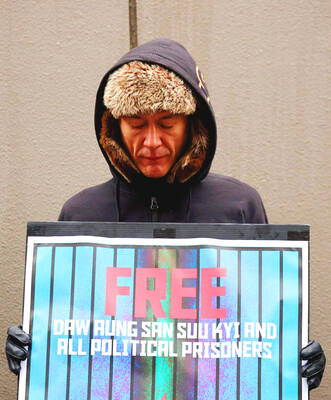A Chinese official’s post on Twitter of an image of an Australian soldier that sparked a furious reaction from Canberra was amplified across social media by unusual accounts, of which half were likely fake, an Israeli cybersecurity firm and Australian experts said.
The digitally altered image of an Australian soldier holding a bloodied knife to the throat of an Afghan child was tweeted on Monday by Chinese Ministry of Foreign Affairs spokesman Zhao Lijian (趙立堅).
Twitter declined Australia’s request to remove the tweet.
The Chinese embassy in Canberra on Friday told ABC television that Australian Prime Minister Scott Morrison’s demand for an apology drew more attention to an investigation into war crimes by Australian soldiers in Afghanistan.
Cyabra, an Israeli cybersecurity firm, said that it was highly probable that an orchestrated campaign had promoted Zhao’s tweet.
Cyabra said it had found 57.5 that of accounts that engaged with Zhao’s tweet were fake and “evidence of a largely orchestrated disinformation campaign” to amplify its message.
The firm did not give any details about who was behind the campaign.
Cyabra said it analyzed 1,344 profiles and found that a large number were created last month and used once, to retweet Zhao’s post.
China called Cyabra’s statement “unwarranted.”
“This is a classic example of spreading false information. Twitter has its own rules managing tweets,” the ministry said on Friday in response to questions from reporters.
The Queensland University of Technology’s Tim Graham analyzed 10,000 replies to Zhao’s tweet.
Accounts originating in China were the most active and 8 percent of replies were from accounts created on the day, or in the 24 hours prior, Graham said.
Many contained duplicated text.
“When not tweeting about Afghan children, they were tweeting about Hong Kong,” he told reporters in an interview.
“If there’s enough of them, those irregularities suggest they were set up for a particular campaign,” he said.
Some of the accounts had already been identified by Graham in a dataset of 37,000 Chinese accounts targeting Australia since June, he said.
Ariel Bogle, a researcher at the Australian Strategic Policy Institute, said that she had also noticed “unusual behavior” by Twitter accounts retweeting or liking Zhao’s post.
“There was a spike in accounts created on November 30 and December 1,” Bogle told reporters, adding that it was too early to determine whether it was coordinated inauthentic behavior or patriotic individuals.
Many of the new accounts only followed Zhao, plus one or two other accounts, she said.
A third of accounts liking Zhao’s tweet had no followers, the institute said.
Earlier this year, Twitter said it had removed 23,750 accounts spreading geopolitical narratives favorable to the Chinese Communist Party and another 150,000 accounts designed to amplify these messages.
A Twitter spokeswoman said that the company remains vigilant, but the Cyabra findings “don’t hold up to scrutiny” because it relied only on publicly available data.
A Cyabra spokeswoman said that its founders are information warfare experts with Israeli military backgrounds and the US Department of State was among its clients.

The Burmese junta has said that detained former leader Aung San Suu Kyi is “in good health,” a day after her son said he has received little information about the 80-year-old’s condition and fears she could die without him knowing. In an interview in Tokyo earlier this week, Kim Aris said he had not heard from his mother in years and believes she is being held incommunicado in the capital, Naypyidaw. Aung San Suu Kyi, a Nobel Peace Prize laureate, was detained after a 2021 military coup that ousted her elected civilian government and sparked a civil war. She is serving a

China yesterday held a low-key memorial ceremony for the 1937 Nanjing Massacre, with Chinese President Xi Jinping (習近平) not attending, despite a diplomatic crisis between Beijing and Tokyo over Taiwan. Beijing has raged at Tokyo since Japanese Prime Minister Sanae Takaichi last month said that a hypothetical Chinese attack on Taiwan could trigger a military response from Japan. China and Japan have long sparred over their painful history. China consistently reminds its people of the 1937 Nanjing Massacre, in which it says Japanese troops killed 300,000 people in what was then its capital. A post-World War II Allied tribunal put the death toll

‘NO AMNESTY’: Tens of thousands of people joined the rally against a bill that would slash the former president’s prison term; President Lula has said he would veto the bill Tens of thousands of Brazilians on Sunday demonstrated against a bill that advanced in Congress this week that would reduce the time former president Jair Bolsonaro spends behind bars following his sentence of more than 27 years for attempting a coup. Protests took place in the capital, Brasilia, and in other major cities across the nation, including Sao Paulo, Florianopolis, Salvador and Recife. On Copacabana’s boardwalk in Rio de Janeiro, crowds composed of left-wing voters chanted “No amnesty” and “Out with Hugo Motta,” a reference to the speaker of the lower house, which approved the bill on Wednesday last week. It is

FALLEN: The nine soldiers who were killed while carrying out combat and engineering tasks in Russia were given the title of Hero of the Democratic People’s Republic of Korea North Korean leader Kim Jong-un attended a welcoming ceremony for an army engineering unit that had returned home after carrying out duties in Russia, North Korean state media KCNA reported on Saturday. In a speech carried by KCNA, Kim praised officers and soldiers of the 528th Regiment of Engineers of the Korean People’s Army (KPA) for “heroic” conduct and “mass heroism” in fulfilling orders issued by the ruling Workers’ Party of Korea during a 120-day overseas deployment. Video footage released by North Korea showed uniformed soldiers disembarking from an aircraft, Kim hugging a soldier seated in a wheelchair, and soldiers and officials